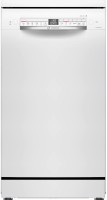Can a dishwasher save money?
We independently test the products and technologies that we recommend.
 |
A little history
The American Josephine invented the dishwasher Cochrane. She never washed the dishes herself, but she was very upset when the servants once again broke something from the family porcelain. And Josephine - by the way, the great-granddaughter of John Fitch, the inventor of the steamboat and locomotive - decided to continue the work of her ancestor. Starting in 1893 with a small laboratory in an old barn, she soon founded the company Kitchen Aid, which specialized in the production of dishwashers.
Luxury or necessity?
The price of a dishwasher, to put it mildly, is considerable. So is it worth giving my wife such an expensive gift? Maybe it's easier to help her with washing dishes every night? Not really. If you wash cups, plates and pots by hand after a family meal, you will spend from 40 to 100 liters of water. The latest models of dishwashers are able to reduce consumption up to 7 liters. At the same time, every ten seconds the optical sensor "examines" the plates, which allows you to optimize the washing process and save up to 30% of time, water and electricity. Another important advantage of a car wash is perfectly clean dishes. After all, no hostess will be able to wash dishes at a water temperature of 75 degrees and provide such a shine of plates and cups as a washing machine. Not to mention the fact that by entrusting kitchen utensils to a car, you will get 300 extra hours a year that you can use for something useful and pleasant.
Which one should I choose?
If you are going to buy a dishwasher in the nearest home appliance store, then the manufacturer does not matter in principle. Because all devices sold in small stores are about the same level in terms of reliability, functionality and price. Affordable dishwashers cost an average of $200 – 500. But in general, in the CIS, prices for a standard-sized car range from 200 to 2,000 conventional units.
First, decide where your assistant will stand. If in a block with kitchen furniture, then you need a built-in option. Such machines are more convenient – they take up less space. But they are also more expensive. Pay attention to the size. The width of full-sized machines is 60 cm, compact – 45. Up to 14 sets can be placed in a full-size, and a family of 3 or more people will provide a full load of such a machine. And a narrow or compact will have to be turned on twice a day. One of the important characteristics is the number of washing programs. There can be from 4 to 12 of them. The more programs, the more economical the machine. But, usually, it is also more expensive.
Like all electrical appliances, cars are distinguished by classes of electricity consumption. The most economical is class A. Next in ascending order of consumption are B, C, E. If the kitchen and dining room are located in a water room, then an important indicator is the noise level. Its value should not exceed 50 dB.
There are two ways to dry dishes: by condensation and forced blowing. In the first case, drying takes place without air intake from the outside: moisture turns into condensate, falling on the cold walls of the chamber. The positive point is the saving of electricity due to the use of residual heat. The disadvantage is that there are stains on the glass and porcelain. The option with a heat exchanger provides the supply of steam up the washing chamber and its rapid removal. In this case, there are no divorces, but energy consumption increases. The second option is blowing hot air with a fan. It gives the best effect, but is the most energy-intensive, and, as a result, expensive.
Briefly about brands
 |
Dishwashers, which today are offered to the buyer by both conventional and online stores, can be afforded by people with almost any income level. The hi-end class is represented by such firms as Miele, AEG, SMEG, Gaggenau, slightly lower in class Siemens and Bosch, then - Zanussi, Asco, Whirlpool, Electrolux, Candy, and the most affordable machines are produced under the brands Ardo, Ariston, Brandt, Beko Indesit. But this classification is conditional – many companies produce both economy-class cars and expensive models.
- Italian dishwashersIndesit and Ariston cost about $300 – 750. They are equipped with drying Turbo dry, which prevents stains from detergents on dishes. Also in the presence of the clic-clac system (allows you to change the height of the shelves), the Crystal cycle (gentle washing) and the cycle of economical washing when the machine is not fully loaded.
- The dishwasherArdo ($400 – 600) can be connected to a hot water supply, thus reducing electricity consumption. But if the hot water is turned off in the summer, then you will have to reconnect to the main line. You can immediately install a special mixer, although it will cost about another $ 100.
- Whirlpool dishwashers ($500 – 900) have an electronic sensor device called the "Sixth Sense", which independently determines the quality of water and tests the progress of the dish washing process every ten seconds, automatically adjusts the temperature, water pumping and the duration of the process. As a result, the washing result meets the requirements of Class A. An incomplete loading mode is also possible.
- The advantage of the Electrolux dishwasher ($300 – 1000) is the Fuzzi Logic system, which determines the transparency of water, as well as an improved protection system against leaks and overflow.
- Modest in design Asko machines ($600 – 1000) have such modern functions: heating dishes (for effective washing of fats), express programme "fast cycle", programs "fast drying" and "additional drying".
- Most of all in the CIS market of Bosch brand dishwashers ($300 – 1500) – only in our catalog you will find about 60 models. They differ in cost, design and technical capabilities – desktop, freestanding, built-in (narrow and full-size). The most expensive models have optical diagnostics of water and a sensor system for measuring stiffness. There is also a timer to delay the start and an indication of the programme execution process.
- Siemens dishwashers ($400 – 1500) are produced by the same concern as Bosch – BSH. Therefore, advanced models use similar advanced technologies. In particular, a Super Cleaning System type system that provides cleaning of the filter and the inner walls of the washing chamber.
- AEG dishwashers ($500 – 1500) use the Fuzzy Logic system, which independently assesses the degree of contamination of dishes and selects the necessary amount of energy and water. These machines have five levels of spraying and ten stages of water hardness adjustment. Accordingly, the high quality of washing dishes. There is also a turbo drying mode.
- If you are ready to spend from $800 to $2000 or more on the purchase of a dishwasher, pay attention to the Miele models. These machines are very convenient and reliable. Their highlight is the Update function, with which you can change the programme parameters - temperature, duration of washing and amount of water. You can reprogram the machine using a laptop that is connected to the machine. All models are equipped with an eco-sensor that monitors the results of washing according to the degree of water transparency.
By the way, it is strongly not recommended to buy dishwashers that have already been used. Advertisements for the sale can be seen both in newspapers and on the Internet. They cost less than $100. Usually, these are outdated models. The software devices of such machines are electromechanical, which means they contain parts that wear out quickly. No one can guarantee that the dishwasher has not worked out its resource for a long time.
Articles, reviews, useful tips
All materials
















